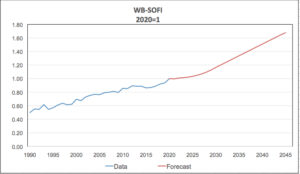World Building State of the Future Index
The State of the Future Index is a composite index that indicates the outlook for the future based on historical data for a selected group of variables that in combination can depict potential systemic change. It is constructed with relevant indicators that are individually forecasted and then aggregated to indicate the potential direction and intensity of change. It shows a potential trend; it is not a projection. Its role is solely to help understand the system and the relationships among its items—how changes to individual or several variables ripple throughout the system.
The State of the Future Index was developed by Ted Gordon in the year 2000 and is computed by The Millennium Project annually. Usually, it uses historical data of at least 20 years, to project 10 years into the future. It can be computed at global, national, or regional levels, or for different sectors or areas of activity, including the relevant indicators.
For the World Building contest, as an exception, the Index projects 25 years into the future, to the year 2050, based on 30 years of historical data. The indicators used to compute the World Building State of the Future Index (WB-SOFI) are:
- GNI per capita, PPP (constant 2017 international $
- Income Inequality (Income share held by highest 10%)
- Unemployment, total (% of total labor force) (modeled ILO estimate)
- Poverty headcount ratio at $1.90 a day (2011 PPP) (% of population)
- Life expectancy at birth (years)
- Prevalence of undernourishment (% of population)
- People using safely managed drinking water services (% of population)
- CO2-equivalent mixing ratio (ppm)
- Literacy rate, adult total (% of people ages 15 and above)
- Number of conflicts (state-based violence)
- Individuals using the Internet (% of population)
- R&D Expenditures (% of GDP)
Although expressing the potential trajectory of the future by one index or line is as accurate as any informed guess, given the relevance of the chosen indicators, it can be an indication of the system’s possible development(s). Nevertheless, combining several variables into a single index can lead to loss of detail, hide certain aspects by compensating losses in some areas with progress in the others, and mask variations among sectors and regions. Therefore, the apparent precision of an index should not be mistaken for accuracy. However, the index offers the opportunity for further sensitivity analysis, which can support evidence-based policymaking, development strategies, and better understanding of the interaction among the elements of the system.
Following is the graphic expression of the WB-SOFI. The entire spreadsheet with computation and the data for the respective variables is available at: WB-SOFI.pdf (as pdf file) and WB-SOFI.xlsx (downloadable excel file).


